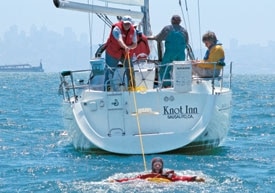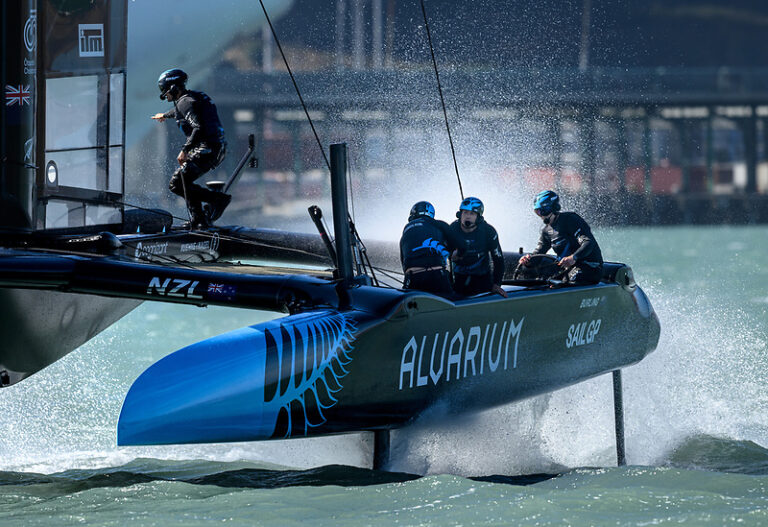
RecoveryPic
While racing sailors usually spend more time practicing man-overboard drills than casual sailors and cruisers, it doesn’t make them immune to being lost overboard.
Two sailors I knew drowned off raceboats in the past three years-one in Long Island Sound in 2002 and one off the coast of New Jersey last fall-so I was thinking well beyond the hypothetical already when I headed to San Francisco Bay last August to participate in the Crew Overboard Retrieval Symposium, an event sponsored by West Marine and Modern Sailing Academy, with support from Cruising Club of America, BoatUS Foundation for Boating Safety and Clean Water, Sailing Foundation of Seattle, Garmin, North Sails, and Landfall Navigation. Last held in 1996, the Symposium included 120 volunteers from different disciplines in the sport as well as industry reps and a handful of boating writers. The plan was to test lifesaving gear introduced since 1996 and to determine which recovery methods worked best.
From the opening day, it was obvious we’d be spending a significant amount of time on the water. Each morning, volunteer crews were given a list of specific tasks to perform on racing and cruising sailboats, ranging from 24 to 56 feet. A designated skipper was in charge of each boat and one of the crew, equipped with a Garmin handheld GPS and a notebook, sailed as a record keeper. The rest of the crew would take turns steering, trimming sails, and trying to retrieve either Styrofoam heads, a 150-pound dummy, or volunteer divers. At the end of the day, each GPS’s track would be downloaded and matched with its respective record-keeper’s written record. The skipper of each boat provided a videotaped debrief. Through all of this, event organizers hoped that after four days of observation, a large amount of valuable data would be in hand and ready to be distilled into a report.
I sailed one day and, to get a better overall picture, spent the rest of the event riding a Vessel Assist rescue RIB. We stood by as boats put “victims” in the water and tried four different methods of returning to the victim, many different techniques of getting the victim aboard, some tried-and-true and new pieces of recovery gear. Details and official observations from the Symposium will be compiled into a report and released before the end of the year, but in the following pages, I’ll share my observations.
Watch your speed
On the first day in particular we saw poor technique, which included approaching the victim at terrifying speeds. On many occasions, once the COB was attached in some way to a retrieval device, the boat was moving at a rate of knots that could potentially drown the very person they were trying to rescue. One valuable tip from our volunteer victims to potential crew overboard was to turn around (back of the head toward the boat) and spread your arms and legs out so your body would plane rather than plow. It was also suggested by several of the volunteer victims that everyone who sails should carry a knife because, if a victim is being towed too fast, he or she can cut themselves free.
Once you’ve lost somebody overboard, reduce your sailplan. When jib sheets are cast off in more than 15 knots of breeze, they become thrashing tentacles that can injure or remove crewmembers from the deck. If the boat is equipped with a roller-furling headsail, it should be rolled; it will be just as easy to roll it out should steerage or boatspeed be required.
You need steerage way and boatspeed to get to your victim, but if you stay close enough to the COB you take away the intricate challenge of trying to balance speed and steerageway that a long approach requires.
The Quick Stop (diagram here) can keep you close enough to the COB to use throwing devices, but the Quick Stop isn’t for everybody. Think about the havoc that a Quick Stop would create on a swing-keel supermaxi sailing 30 knots downwind.
Talk to the victim
Communication with the crew overboard is important. Victims are desperate to know they’re being recovered. If you’re close enough, yell to the COB that you have them in sight and are trying to get to them ASAP. Once the victim is secured to the boat with a retrieval device, it’s important to continue the eye and voice contact. On the last day I watched a victim try to tell a boat’s crew they were towing him too quickly. The entire crew was facing forward, occupied with sailhandling, as the victim was towed along, hapless and helpless, at 5 knots.
Don’t forget the basics
Hit the COB/MOB button on the GPS and get on the radio and broadcast PAN-PAN as soon as you lose someone. The more help around, the better the chance of recovery. If you lose sight of the victim, immediately broadcast a MAYDAY and set off the EPIRB. You can always cancel both once the victim is back aboard. Use your engine; extra points aren’t awarded if you recover your COB under sail. If you use the engine, don’t rush. Make sure every line is accounted for and none are trailing from the boat ready to wrap around your prop.
Try to recover the COB to leeward; there will be less wind and wave action than a windward recovery, and the breeze will blow you toward the victim rather than away. Stern ladders and swim platforms only work when the sea condition is benign. When a boat is pitching in large waves, the stern could easily injure someone trying to board the boat via the transom.
Determine which return technique works best for your type of boat. The Corsair 24 trimaran’s crew quickly figured out that the Quick Stop technique stopped the boat so quickly they couldn’t reach the victim. When they tried the Figure 8, the speed built too quickly. In the end, no technique was accepted as perfect for the speedy tri; it depends upon the conditions.
We’ll discuss gear in the follow-up article (Best Recovery Gear), but from our observations, the LifeSling-developed as a result of an earlier COB seminar-works extremely well, as does its descendant, the inflatable LifeSling. MOM units, while expensive, are well worth the price. They are as complete a rescue package as can be delivered to a MOB victim. A simple heaving line works well if the victim is close and conscious and should be a part of the safety gear on every boat longer than 15 feet.
And finally, the obvious: always wear a PFD and augment it with a harness and jacklines when sailing offshore or alone.
For more information on the Crew Overboard Retrieval Symposium, organized by John Connolly, Chuck Hawley, Karen Prioleau, John Rousmaniere and Ruth Wood,
This article first appeared in our Nov./Dec. 2006 issue.









